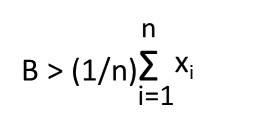I recently bought a tee shirt with this on it…

Which translates to “Be. Greater than. Average. Isn’t this what Marketers are always striving for…e.g., beat advertising performance norms, create growth in mature categories (another way to say “better than average” when you think about it). So how do you beat the average when everyone uses top flight ad agencies, has tech stacks, has 80% or more ACV distribution, and everyone gives a big portion of their budget to Google, Facebook, and TV?
I’m not going to talk about the virtues of scale, consolidation, or bringing selected functions in-house. Those are obvious. My interest is in creating and leveraging the math of repeatable success in an era of modern marketing.
Here are four math-driven ideas that will consistently get your return on paid media to beat tthe averages.
Targeting the Movable Middle and their lookalikes. The idea of targeting those with a 20-80% probability of choosing your brand started as a theory based on math (calculus, confirmed with simulations). Now case studies are showing it to be “the closest thing to certain” in marketing. Working with the MMA and my consulting clients, I now have a dozen or more case studies where Movable Middle consumers were anywhere from 2 -19 TIMES more responsive. How can you not target them with extra media knowing this?! With math, I can estimate the improvement in ROAS by targeting this segment…typically around a 50% improvement. How can you actually target the Movable Middle? The MMA has an implementation guide that explains…but the topline is that frequent shopper data, location data, first party data, and on-boarding properly designed brand trackers will do the trick.
And if you beat the average, someone is going to be below average…who? Those who follow advice to construct broad reach media plans, target advertising to non-buyers in the hopes of conquest, or who target based on attitudinal segmentation (I have not seen that work yet.)
Target heavier users. The math of why this works is not what you might think…it is based on Erwin Ephron’s principle of recency…those closer to a purchase will be more responsive to advertising. It has been proven by many (including me, who proved it doubles ROAS). So how do you find those close to making a purchase? One simple way is to target heavier users because probabilistically, they are more likely to be close to an upcoming purchase.
Do everything you can to maximize repeat rate. Brand penetration is not the key to growth, repeat rate is. Repeat rates increase in response to properly designed marketing programs, correctly targeted paid media, and, of course, great product performance and customer service. And repeat rate is linearly related to market share in an easy to estimate equation that comes from both Markov math and the math of Beta and Dirichlet distributions.
While it is true that brand share is also highly correlated to penetration, that is an artifact and should not be the focus of your paid media…repeat purchases and customer retention should be. Eating ice cream is highly correlated to hot, sunny days but the former does not cause the latter.
A recent study I worked on confirmed what the Markov math suggests…that growth comes from superior repeat and retention rates…holding onto that consistent trickle of new brand triers coming to the brand as part of a stochastic process. In fact, retained buyers accounted for well over 90% of brand penetration.
No matter how you look at it, repeat and retention are the keys to sustainable brand growth.
Measure the effectiveness of everything you do with an eye towards generalization. Get your data assets in order for MTA analytics and eventually unified modeling. This means you are linking together ad serving and conversion outcomes by common identifiers. I would also link together survey research like brand trackers by using on-boarded survey panels. Ruthlessly measure the effectiveness of everything you do (most marketers do not do this) and do more of what works. Then look for generalizable patterns.
Get your paid media targeting and tactics right, focus on retention and you will prove that greater than average marketing delivers greater than average growth.
Be greater than average.


This is really fascinating, You are an overly skilled blogger.
I’ve joined your rss feed and look ahead to looking for
more of your magnificent post. Additionally, I’ve shared your website in my social networks